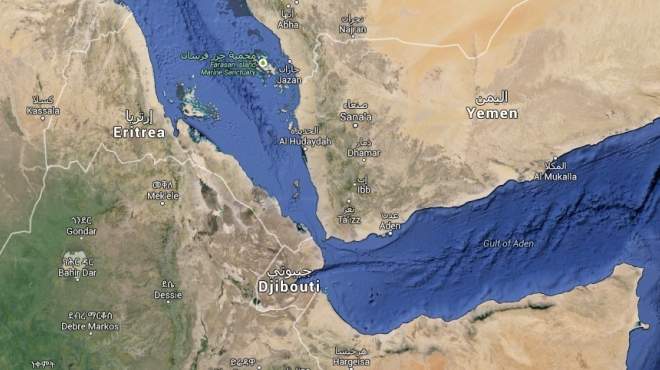Bab al-Mandab Shipping Chokepoint Under Threat
Cmdr. Jeremy Vaughan, USN and Simon Henderson/The Washington Institute/March 01/2017
Reports of Yemeni rebel mining activity are only the latest in a string of threats to international vessels transiting the narrow link between the Suez Canal and the Indian Ocean.
On February 9, the U.S. Office of Naval Intelligence issued an alert warning commercial vessels about the risk of mines in the Bab al-Mandab Strait: “The U.S. Government has reason to believe in late January, mines were laid by Houthi rebels in Yemeni territorial waters in the Red Sea close to the mouth of Mocha harbor.” The alert follows a number of other troubling incidents in the strategic waterway over the past few months. Saudi and Emirati naval vessels have been attacked while trying to enforce a blockade on the Iranian-supported Houthi rebels who control large parts of Yemen. And last October, patrolling U.S. Navy ships were targeted as well. Diplomatic efforts to end Yemen’s civil war appear to be getting nowhere, and the fighting on land is largely deadlocked, though forces loyal to the internationally recognized government of President Abdu Rabu Mansour Hadi recently captured Mocha port near the Bab al-Mandab.
Iran’s motives for helping the Houthis are unclear but have the effect of challenging Saudi Arabia, which views the fighting as a proxy war. More incidents at sea, especially involving civilian shipping, could further internationalize the conflict and spur other actors to intervene. In terms of capability and tradition, the leadership role in any such effort to safeguard freedom of passage would necessarily be taken by the U.S. Navy.
A KEY CHOKEPOINT
In a 2014 web post describing heavily transited oil chokepoints in the Middle East and elsewhere, the U.S. Energy Information Administration noted that blocking such waterways, even temporarily, “can lead to substantial increases in total energy costs and world energy prices.” The Bab al-Mandab, which controls access to the Red Sea and the southern end of the Suez Canal, is particularly crucial at present because of Egypt’s reliance on imported liquefied natural gas to maintain its electricity supplies. One LNG tanker destined for Egypt transits the strait each week. If passage were impeded, those shipments — and all other vessels heading to Egypt and the Mediterranean Sea — would have no alternative but to make the long voyage around the southern tip of Africa.
The Bab al-Mandab is around ten miles wide at its narrowest point, where the Yemeni island of Perim protrudes into the waterway toward Eritrea and Djibouti. Under an international traffic separation scheme, northbound international shipping uses a two-mile-wide lane on the Arabian side just west of Perim, while southbound traffic uses a similar lane on the African side. Separated by just over a mile of water, the two lanes work well for international traffic but are ignored by smaller local ships and fishing vessels. More than sixty commercial ships transit the strait every day, and several passenger cruise liners use the route as well.
THE THREATS
Houthi rebels have attacked warships in or near the strait on at least four occasions since last fall. On October 1, antishipping cruise missiles fired from the Houthi-controlled coastline severely damaged the Swift, an Emirati-operated troop landing and logistics ship. In the following weeks, the destroyer USS Mason successfully defended itself against three similar attacks. The U.S. Navy launched a Tomahawk missile strike to knock out coastal radar sites that may have provided targeting information for the attacks. No further antishipping missile attacks have been reported since then, but radar sites can be rebuilt, and the Houthis’ stores of such missiles have not been destroyed, so the threat remains.
Additional threats have emerged in the past few weeks and may already be affecting international shipping patterns. The recent U.S. government warning about mines in the Bab al-Mandab advised ships to transit the strait only during daylight. Moored mines have a notorious tendency to break free of their tethers and could ramp up the risk to all ships in the area.
Another new threat surfaced when a Saudi frigate was attacked off the Houthi-controlled port of Hodeida on January 30. Initially thought to be a suicide speedboat, the attacker is now assumed to have been a remote-controlled drone craft similar to the type Iranian smugglers employ to pick up contraband from Oman’s Musandam Peninsula in the Strait of Hormuz, a Persian Gulf chokepoint. The UAE also has such craft (which it uses for target practice), so it is conceivable that the attack was conducted by a lost Emirati boat recovered by Iran. U.S. warships transiting the Strait of Hormuz are routinely harassed by small boats from Iran’s Islamic Revolutionary Guard Corps Navy (IRGCN), but weaponized speedboat drones, known in the military as unmanned surface vehicles (USVs), change the danger profile into a credible threat. An attacking USV must be disabled at distance from a warship’s hull, a task that could prove exceptionally difficult during a swarming attack by multiple boats.
Furthermore, Iran’s familiarity with explosively formed penetrators (EFPs) means that such technology may soon be seen at sea. Fortunately, the difficulty in remotely placing such a narrowly focused explosive against a target’s hull mitigates some of the risk; this could explain why the January 30 attack seemed to result in such minor damage, assuming an EFP was on board. Even so, an EFP-laden USV that gets through a ship’s defenses could sink it.
RESPONSES
Any future cruise missile attacks on U.S. vessels should be met with additional strikes on radar control sites and other shore installations. Reconnaissance assets patrolling Yemen’s shorelines, ports, and waterways should be ready and able to destroy cruise missiles that actively threaten shipping and maritime forces. Any detected storage sites for mines would also be a worthwhile target.
Meanwhile, the United States should ramp up military training, tactics, and procedure transfer to the Saudi and Emirati navies, drawing on the U.S. Navy’s long experience defending against small-boat threats. Improved ship and helicopter weapons systems optimized for medium-range surface engagement would help the Saudi-led coalition increase their ships’ resilience to those threats as well, though such transfers and related training would take time.
A cooperative minesweeping mission should be considered as well. Such joint efforts in the area are not new — in 1984, for example, several ships reported seeing mines between the Suez Canal and the Bab al-Mandab, prompting an international mine countermeasures campaign. After much searching, several mines dating back as far as World War II were found, but British minesweepers also discovered a newly laid, advanced Soviet mine that was later traced to a Libyan ferry.
Since 2012, the U.S. and British navies have spearheaded the annual International Mine Countermeasures Exercise in the Persian Gulf, Gulf of Oman, and Red Sea, now the largest such maritime exercise in the world. Thirty nations from six continents participated in 2016. This year’s IMCMEX (whose date remains undisclosed for now) is an opportunity to send a strong signal about international commitment to security in the Bab al-Mandab. Now that Mocha harbor is reportedly back in the Hadi government’s hands, clearing mines there could be a task to incorporate in this year’s exercise, but only if the area is truly secure. Specialized minesweeping ships form part of the American and British naval contingents in the Persian Gulf and could be deployed to the Bab al-Mandab quickly.
In addition, several foreign navies are already stationed close to the strait. Djibouti provides bases for French and American forces as well as Japanese and Chinese military facilities. Moreover, Saudi Arabia is in talks to establish a base there, while the UAE has opted for a base at the port of Berbera in the self-declared Somaliland, notionally part of Somalia. And Israel is widely believed to have patrol boats based on Eritrean islands just north of the strait.
CONCLUSION
The United States and its allies must be prepared for more incidents in the Bab al-Mandab. Contingency planning should include immediate steps to maintain free passage for commercial shipping, and to ensure that humanitarian aid can reach Yemen’s estimated population of seven million, about a quarter of which reportedly faces famine. It is difficult to imagine any such intervention or parallel diplomatic effort succeeding without Washington taking the lead role.
Cmdr. Jeremy Vaughan, U.S. Navy, is a Federal Executive Fellow at The Washington Institute who has completed multiple deployments to the Persian Gulf. Simon Henderson is the Institute’s Baker Fellow and director of its Gulf and Energy Policy Program. The views expressed herein are those of the authors and do not reflect the official policy or position of the U.S. Navy, U.S. Department of Defense, or U.S. government.
http://www.washingtoninstitute.org/policy-analysis/view/bab-al-mandab-shipping-chokepoint-under-threat






















